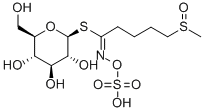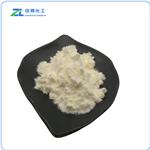Description
Glucoraphanin is a glucosinolate found in broccoli, cauliflower, and mustard. Glucoraphanin is converted to sulforaphane by the enzyme myrosinase. In plants, sulforaphane deters insect predators and acts as a selective antibiotic. In humans, sulforaphane has been studied for its potential affects in neurodegenerative and cardiovascular diseases. Due to the potential health benefits, a variety of broccoli has been bred to contain two to three times more glucoraphanin than standard broccoli.
Discovery
In the early 1990’s, scientists at Johns Hopkins University (JHU) identified a compound derived from broccoli called glucoraphanin [2]. Glucoraphanin acts as part of the plant’s defense system. In fact, once converted to its bioactive form, sulforaphane, it is responsible for the characteristic sulfur smell/taste of broccoli. Glucoraphanin belongs to a category of compounds called glucosinolates, which are naturally found in cruciferous vegetables –with broccoli being the king of glucoraphanin. It is converted into sulforaphane by an enzyme found in broccoli called myrosinase or, if this enzyme is deactivated through the cooking process, the body's gut microflora will perform the conversion.
Glucoraphanin in broccoli
Glucoraphanin is a powerful and long-lasting antioxidant, found primarily in broccoli. However, the amount varies tremendously from one broccoli plant to another with no way for consumers to tell how much glucoraphanin is in the broccoli they buy. It has also been shown that this phytonutrient is present in much higher concentrations in the broccoli seeds and 3-day old broccoli sprouts. Brassica created TrueBroc® glucoraphanin from broccoli seeds in order to provide consumers with a concentrated source of glucoraphanin that contains consistent and meaningful levels. Glucoraphanin belongs to a category of compounds called glucosinolates which are naturally found in cruciferous vegetables. Glucosinolates are enzymatically converted into isothiocyanates, which are active in the body. This enzymatic conversion is performed by myrosinase, which is also found naturally in cruciferous vegetables.
Bioavailability studies indicate that glucoraphanin can be absorbed intact, but when eaten within broccoli it is primarily converted to sulforaphane during chewing, which is then absorbed in the upper intestine. Intact glucoraphanin can also be converted to sulforaphane by gut microflora (Holst & Williamson, 2004)
Uses
Glucoraphanin is a natural glycoinsolate found in cruciferous vegetables. Glucophanin (Sulforaphane), is a bioactive component in brocolli and is digested by gut bacteria to produce chemopreventive agents.
Definition
ChEBI: A thia-glucosinolic acid that is glucoerucin in which the sulfur atom of the methyl thioether group has been oxidised to the corresponding sulfoxide.



